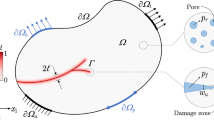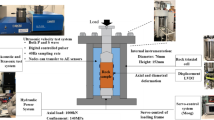Abstract
In this work, we present a newly developed workflow to study the combined effect of shear and normal stresses upon a preexisting fracture plane. This workflow is used to study the behavior of both single grain and polycrystalline materials, with varying material properties. The surface roughness and aperture of preexisting fractures are highly dependent upon the dynamic stress behavior within rock formations. Due to shear slippage, or variation in normal stress, a preexisting fracture may become more or less conductive, leading to changes in effective porosity, where such changes are caused by purely elastic deformation, plastic deformation, material failure, or a combination thereof. The numerical modeling framework demonstrated herein is based upon the meshless material point method (MPM). In using MPM, the workflow can capture large deformations due to applied shear and normal stresses. Additionally, no special geometric treatment is required at the point of contact between fracture surfaces. Models involving purely elastic, single-grain materials, as well as more complex, plastic, polycrystalline bodies, are presented, highlighting the flexibility of the proposed approach.




















Similar content being viewed by others
References
Al-Busaidi A, Hazzard JF, Young RP (2005) Distinct element modeling of hydraulically fractured Lac du bonnet granite. J Geophys Res Solid Earth. https://doi.org/10.1029/2004JB003297
Aimene YE, Nairn J (2014) Geomechanical modeling of multiple hydraulic fractures interacting with natural fractures using the material point method. Application to the Marcellus and Eagle Ford
Abe K, Soga K, Bandara S (2013) Material point method for coupled hydromechanical problems. J Geotech 140:1–16
Moormann C, Hamad F (2015) MPM dynamic simulation of a seismically induced sliding mass. IOP Conf Ser Earth Environ Sci 26:012024
Raymond Samuel J, Jones Bruce, Williams John R (2018) A strategy to couple the material point method (MPM) and smoothed particle hydrodynamics (SPH) computational techniques. Comput Part Mech 5(1):49–58
Raymond S, Lemiale V, Ibrahim R, Lau R (2014) A meshfree study of the Kalthoff–Winkler experiment in 3D at room and low temperatures under dynamic loading using viscoplastic modelling. Eng Anal Bound Elem 42:20–25
Sulsky D, Chen Z, Schreyer HL (1994) A particle method for history-dependent materials. Comput Methods Appl Mech Eng 118:179–196
Harlow FH, Amsden AA (1971) A numerical fluid dynamics calculation method for all flow speeds. J Comput Phys 8(2):197–213
Sulsky D, Zhou S, Schreyer HL (1995) Application of a particle-in-cell method to solid mechanics. Comput Phys Commun 87:236–252
Abe K, Konagai K (2015) Numerical simulation of a series of flume tests with dry and wet sands by using depth averaged material point method. In: The international symposium on geomechanics from micro to macro (IS-Cambridge 2014), Cambridge, 2014
Raymond S, Aimene YE, Nairn J, Ouenes A (2015) Coupled fluid-solid geomechanical modeling of multiple hydraulic fractures interacting with natural fractures and the resulting proppant modeling proppant distribution in the presence of natural fractures using the material point method (MPM ). In: SPE Canada unconventional resources conference
Lemiale V, Nairn J, Hurmane A (2010) Material point method simulation of equal channel angular pressing involving large plastic strain and contact through sharp corners. Comput Model Eng Sci 70(1):41–66
Deborah Sulsky, Kaul A (2004) Implicit dynamics in the material-point method. Comput Methods Appl Mech Eng 193:1137–1170
Sulsky D, Schreyer HL, Peterson K, Kwok R, Coon M (2007) Using the material-point method to model sea ice dynamics. J Geophys Res Ocean 112(August 2006):1–18
Sulsky D, Peterson K (2011) Toward a new elastic–decohesive model of Arctic sea ice. Phys D Nonlinear Phenom 240(20):1674–1683
Nairn J (2003) Material point method calculations with explicit cracks. Comput Model Eng Sci 4(6):649–663
Bardenhagen SG, Brackbill JU, Sulsky D (2000) The material-point method for granular materials. Comput Methods Appl Mech Eng 187(99):529–541
ZdzisŁaw Wieckowski, Youn Sung K, Heum Yeon Jeoung (1999) A particle-in-cell solution to the silo discharging problem. Int J Numer Methods Eng 45(February 1998):1203–1225
Deb D, Pramanik R (2013) Failure process of brittle rock using smoothed particle hydrodynamics. Eng Mech 139(November):1551–1565
Jaeger JC, Cook NG, Zimmerman R (2009) Fundamentals of rock mechanics. Wiley, Hoboken
Grady DE, Kipp ME (1980) Continuum modelling of explosive fracture in oil shale. Int J Rock Mech Min Sci Geomech Abstr 17(3):147–157
Melosh HJ, Ryan EV, Asphaug E (1992) Dynamic fragmentation in impacts: hydrocode simulation of laboratory impacts. J Geophys Res Planets 97(E9):14735–14759
Das R, Cleary PW (2010) Effect of rock shapes on brittle fracture using smoothed particle hydrodynamics. Theor Appl Fract Mech 53(1):47–60
Cleary PW, Pereira GG, Lemiale V, Piane CD, Clennell MB (2016) Multiscale model for predicting shear zone structure and permeability in deforming rock. Comput Part Mech 3:179–199
Morris JP (2012) A numerical investigation of the scaling of fracture stiffness. In: 46th U.S. rock mechanics/geomechanics symposium
Morris JP, Jocker J, Prioul R (2013) Exploring alternative characterizations of fracture stiffness and their respective scaling behaviors. In: 47th U.S. rock mechanics/geomechanics symposium
Drazer G, Koplik J (2000) Permeability of self-affine rough fractures. Phys Rev 62:8076
Raymond SJ, Jones BJ, Williams JR (2019) Modeling damage and plasticity in aggregates with the material point method (MPM). J Comput Part Mech 6:371–382
Author information
Authors and Affiliations
Corresponding author
Additional information
Publisher's Note
Springer Nature remains neutral with regard to jurisdictional claims in published maps and institutional affiliations.
Rights and permissions
About this article
Cite this article
Raymond, S.J., Jones, B.D. & Williams, J.R. Fracture shearing of polycrystalline material simulations using the material point method. Comp. Part. Mech. 8, 259–272 (2021). https://doi.org/10.1007/s40571-020-00327-4
Received:
Revised:
Accepted:
Published:
Issue Date:
DOI: https://doi.org/10.1007/s40571-020-00327-4




